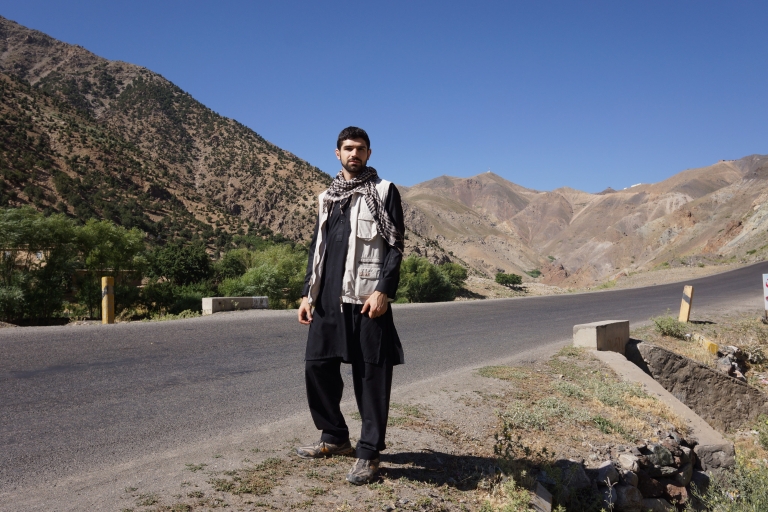Noah Arjomand wants to directly connect his scholarship to the public good. As the Mark Helmke Postdoctoral Scholar in Global Media, Development and Democracy for the Center for International Media Assistance and the Indiana University Hamilton Lugar School of Global and International Studies, Arjomand is finding ways to share his research on cross-cultural communications with the broader public.
“People seem to take public scholarship really seriously here at IU, which is great and totally my approach to doing things,” he said. “I’m not that interested in writing solely for other sociologists in journals that nobody else will read.”

Part of Arjomand’s postdoctoral work is creating a video series in collaboration with the Center for International Media Assistance, which is part of the National Endowment for Democracy, about links between media and democracy. The first video about media capture was released this summer, and another focused on media ethics and featuring voiceover from The Media School’s Elaine Monaghan will be released soon.
Arjomand said the videos, which are animated and accessible, specifically target younger YouTube users. Increasingly, people under 20 are naming YouTube as their primary source for information. But according to Arjomand, many people producing popular videos for the platform are interested in spreading misinformation or sensationalizing stories to garner more clicks.
“One of the advantages of working with universities and nonprofit organizations is that the point is not to chase clicks,” Arjomand said. “We are able to focus on creating things that are adding to the conversation hopefully with a bit more credibility and honesty.”
Arjomand has also received a grant from the IU Arts and Humanities Council’s Public Humanities Project to share knowledge about media in a different venue. He and visiting film director and producer Adam Isenberg will host video editing workshops this month at high schools in Salem, Orange County and Nashville as well as at the Monroe County Public Library in Bloomington with support from the Center for Documentary Research and Practice.
Arjomand and Isenberg are in postproduction for a documentary film about Arjomand’s mother’s life with amyotrophic lateral sclerosis, a project that is also being funded by the grant from the council. In the workshops, groups will be given about an hour of footage not being used in the film to cut into a short scene. Each group will be instructed to craft their scene in a way that casts the characters in a different way.
“I think the assumption about news or documentaries is that the finished product is completely documenting reality,” Arjomand said. “I think what will become apparent to participants is that if you turn one hour of footage into three minutes, the way you select and order shots makes a massive difference in what kind of story you tell.”
While Isenberg is in Bloomington, two of his films will be screened on campus. IU Cinema will show “Ana Yurdu (Motherland),” produced by Isenberg and directed by his wife, Senem Tüzen, which follows a recently divorced Turkish woman who leaves behind her life in Istanbul and finishes her novel in her deceased grandmother’s rural home. “Una Vida sin palabras (A Life Without Words),” a documentary about young deaf adults in rural Nicaragua who gain their first experience of communication through sign language, will screen at the IU Moving Image Archives on Sept. 19.
“Motherland” is part of a three-film series at IU Cinema organized by Arjomand called “Between Worlds: Cultural Hybridity in Turkish Film.” The series explores cultural hybridity and what it means to live between worlds, with Turkey, a country that bridges East and West, at its center. Isenberg, who is an American living in Turkey, will participate in a Q&A after the film as well as meet with IU Turkish language students.

A shared interest in Turkey is initially what brought Arjomand and Isenberg together. Arjomand’s dissertation and forthcoming book focus on “fixers” in Turkey who act as interpreters and guides for foreign journalists, how they shape the news behind the scenes and how they bridge the gap between different cultures. He’s been interested in Turkey since he was an undergraduate, when he took a year off to research the Kurdish population in Turkey, Northern Iraq and Iran. He also held an internship with the Committee to Protect Journalists, working with Iranian journalists seeking asylum in Turkey.
These experiences have shaped how Arjomand thinks about media and journalism and his latest research into a different type of fixer for journalists: Twitter. He and School of Informatics, Computing and Engineering visiting lecturer Ali Ghazinejad are studying how journalists are using Twitter as a news gathering tool, what is considered newsworthy by journalists using Twitter, and who or what is being overlooked when journalists gather news on the platform.
“The reliance of journalists on social media changes our information diet and can complicate assumptions about who is really producing or influencing media,” Arjomand said. “Typically, only one or two people get bylines on stories, and everything else that went into reporting it is invisible. We need to take Twitter mediation seriously if we want to understand how knowledge gets spread and be able to more critically read news every day.”

